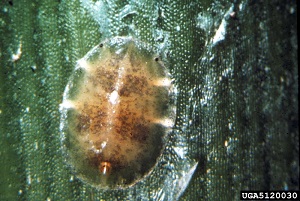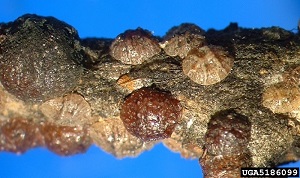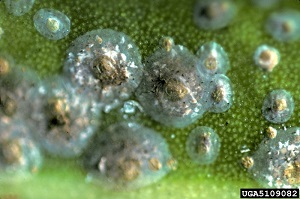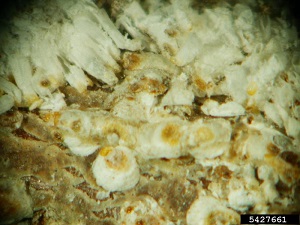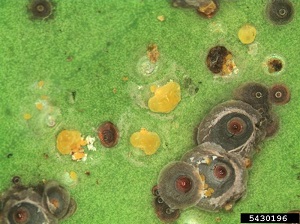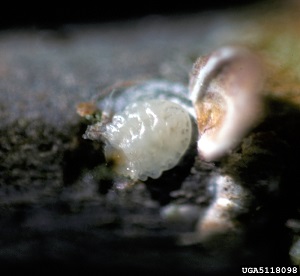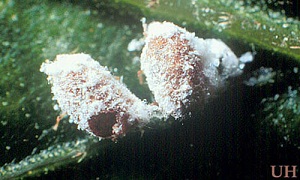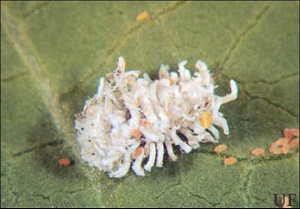| Annona Pests | ||||||||||||||||||||||||
|---|---|---|---|---|---|---|---|---|---|---|---|---|---|---|---|---|---|---|---|---|---|---|---|---|
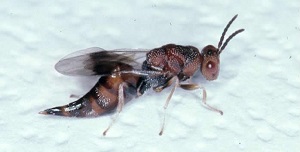 Fig. 1  Annona seed borer 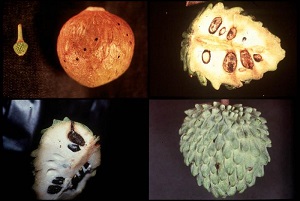 Fig. 2  Annona fruits with symptoms of seed borer infestation 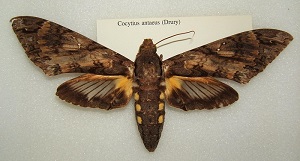 Fig. 3  Cocytius antaeus adult 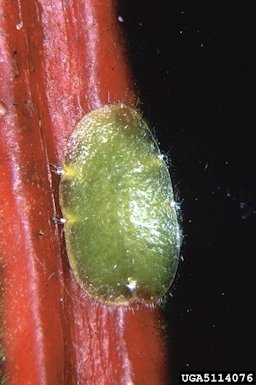 Fig. 4 Soft scale (Philephedra tuberculosa) Nakahara & Gill, 1985 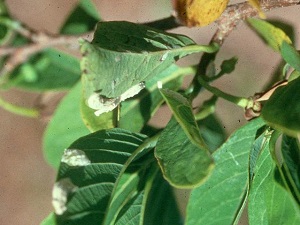 Fig. 5  Philephedra tuberculosa infesting atemoya 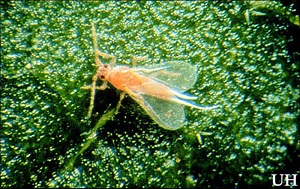 Fig. 14  Adult male pink hibiscus mealybug, Maconellicoccus hirsutus. Notice the two long waxy "tails" 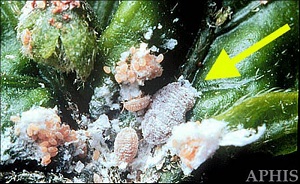 Fig. 15  Adult female (arrow) and offspring of the pink hibiscus mealybug, Maconellicoccus hirsutus 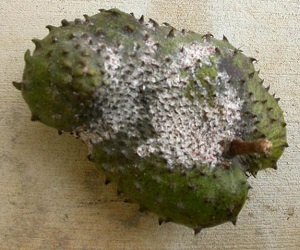 Fig. 16  Mealybug infestation on soursop 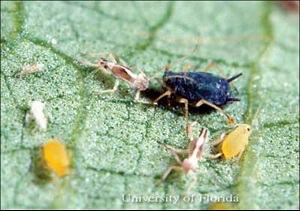 Fig. 20  Nymphs (mixed ages) and dark form of wingless adult of melon aphids, Aphis gossypii 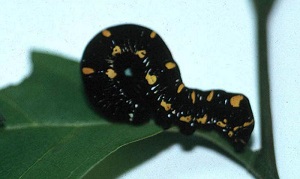 Fig. 21  Larva of G. nutrix 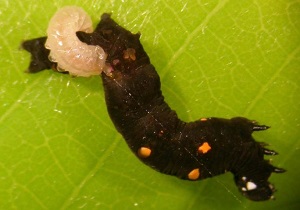 Fig. 22  G. nutrix parasitized by a braconid wasp 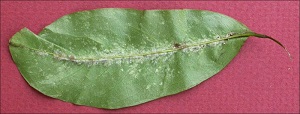 Fg. 23  Leaf of soursop infested with Aceria annonae 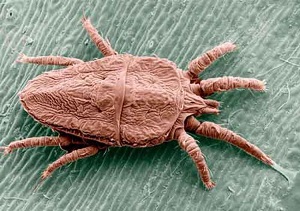 Fg. 24  Adult female false spider mite, Brevipalpus phoenicis 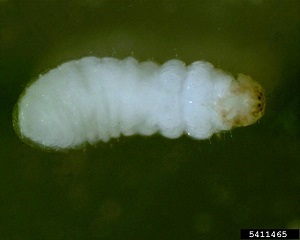 Fig. 25  Redbay ambrosia beetle (Xyleborus glabratus) 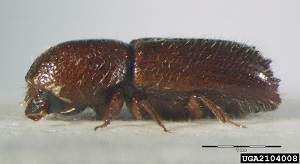 Fig. 26  Ambrosia beetle (Xyleborus monographus)
|
Two
hundred and ninety-six species of arthropods are associated with Annona
spp. in the Neotropics. The families most frequently observed are
Coccidae (Homoptera), Noctuidae, Oecophoridae (Lepidoptera), and
Eurytomidae (Hymenoptera). The most common species in Florida are Bephratelloides cubensis,
(Hymenoptera: Eurytomidae), Cocytius
antaeus (Lepidoptera: Sphingidae), and the papaya scale Philephedra tuberculosa.
Larvae of the moths Gonodonta
nutrix and G.
unica feed on leaves, but they are heavily parasitized by
braconid wasps. 2 Several other species of insects and mites may cause minor losses. In Florida, the foliage feeders most frequently reported on Annona are scales, mealybugs, leafhoppers and whiteflies (Homoptera), lace bugs (Hemiptera), some Lepidoptera and mites. 2 Annona Seed Borer Bephratilloides cubensis The Annona seed borer (ASB) is the most important insect pest of atemoya and sugar apple in Florida. Female ASB lay their eggs into the young seeds of fruits with subsequent larval development inside the fruit and emergence of the adult from the fruit; ruining the fruit in the process. ASB populations increase during the summer and peak during August-September. Symptoms of insect damage include small black, holes on the fruit surface, and brown to black colored decay of the fruit. Bagging individual fruit in small paper lunch bags will prevent the ASB from infesting fruit. Please contact your local UF/IFAS Extension agricultural agent for control information. 1 Bephratelloides spp. develop strictly in Annona seeds. Economic damage occurs when the adults chew their way out of the fruit, creating a 2 mm diam tunnel that provides entry for other insects and decay organisms. B. cubensis is thelytokous, reproducing without males. It has approximately 4-5 generations per year. The egg stage lasts 12 to 14 days, the larval stage 6-8 weeks, the pupal stage 12-18 days, and the adult rarely lives beyond 15 days. No significant native parasitization or predation of Bephratelloides spp. has been reported. In Florida, the fungus Beauveria bassiana was applied to B. cubensis adults under laboratory conditions has provided 90% adult mortality for 8 days after treatment. 2 Further Reading Pollinator and Insect/Mite Management in Annona spp, University of Florida pdf Giant Sphinx Moth Cocytius antaeus Is a moth of the Sphingidae family. It is found from Brazil through Central America and into the southern parts of Texas and Florida in the United States. 3 The wingspan is 126–178 mm. Very rare in North America, it is the only insect in the continent with a long enough proboscis to pollinate the similarly rare Ghost Orchid. 4 The larvae feed on Annona glabra, A. reticulata, A. purpurea, A. holosericea and Rollinia membranacea. 4 Soft Scales Philephedra scale (Philephedra n.sp.) (Fig. 4) attacks mature and immature leaves, leaf petioles, young stems, and fruit. Most commonly these scales are found on the underside of leaves. Damage from heavy infestations result in loss of tree vigor, leaf browning and drop, and stem dieback. Damage from heavy infestations result in loss of tree vigor, leaf browning and drop, and stem dieback. Please contact your local UF/IFAS Extension agricultural agent for control information. 1 Plumose scale (Morganella longispina). Plumose scale attacks the shoots and stems of atemoya trees. Plumose scales are dark brown to grayish brown in color, circular in shape, and are often found infesting the crotch angle areas of stems and shoots. Damage from heavy infestation result in loss of tree vigor, leaf browning and drop, and stem and shoot dieback. Please contact your local UF/IFAS Extension agricultural agent for control information. 1 In Florida, the scales, Parasaissetia nigra, Saissetia coffeae, S. oleae and P. tuberculosa cause damage by feeding on sap. Sudden increases in populations of these insects coincide with plant stress and absence of effective natural enemies. 2
Fig. 6. Black scale (Parasaissetia nigra), adults Fig. 7. Hemispherical scale (Saissetia coffeae), adult Fig. 8. Black scale (S. oleae), adults Armored Scales Armored scales are uncommon and include Aspidiotus destructor Signoret, Pseudaulacaspis pentagona (Targioni-Tozetti), Chrysomphalus aonidum (L.), (Morgan), C. dictyospermi, Howardia biclavis (Comstock).
Fig. 9. Coconut scale (A. destructor), adults and early instars Fig. 10. White peach scale (P. pentagona), infestation on cherry Fig. 11. Florida red scale (C. aonidum) Fig. 12. Dictyospermum scale (C. dictyospermi), adult Fig. 13. Mining scale (Howardia biclavis), adult Please contact your local UF/IFAS Extension agricultural agent for control information. Further Reading Philephedra Scale on Glaucous Cassia, University of Florida, Lee County pdf Mealy bugs Pseudococcus sp. Mealy bugs are generally found at the stem-end of the fruit and/or the shady side of the fruit. Mealy bugs are small, white, scale insects with wispy protuberances along their surface. They exude a sticky, sugary substance, which becomes colonized by fungi, giving the fruit surface (and sometimes adjacent leaves) a sooty appearance; referred to as sooty mold. 1 The Pink hibiscus mealybug (Fig. 15), Maconellicoccus hirsutus (Green), cause severe damage to soursop. M. hirsutus is an extremely polyphagous species. It affects at least 74 plant families, about 144 genera. Some major hosts include mango, hibiscus, palms, coffee, grape, citrus and Annona spp. 2 Please contact your local county agricultural cooperative extension Agent for control information.
Fig. 17. Freshly-laid eggs of the pink hibiscus mealybug, M. hirsutus, are orange but become pink before they hatch. Fig. 18. Two pink hibiscus mealybug, M. hirsutus, mummies (parasitized mealybugs). Note parasitoid exit hole on the bottom left mummy. Fig. 19. The Cryptolaemus larvae are covered with a white flocculent secretion and may be confused with pink hibiscus mealybugs but are important predators and should not be destroyed. Further Reading Pink Hibiscus Mealybug National Pest Alert, USDA–CSREES Integrated Pest Management Centers in cooperation with National Plant Diagnostic Network, APHIS, National Plant Board and the 1862 Land-Grant Universities pdf Pink Hibiscus Mealybug Maconellicoccus hirsutu (Green), University of Florida pdf Aphids The cotton aphid, Aphis gossypii Glover and the black citrus aphid, Toxoptera aurantii (Boyer de Fosncolombe), infest young leaf shoots. 2 Further Reading Pest Identification Guide: Cotton (Melon) Aphid, Aphis gossypii Glover, University of Florida pdf Lepidopterous Leaf Feeders Gonodonta sp. In Florida, larvae of the fruit piercing moths, Gonodonta nutrix (Fig. 21) and G. unica feed on tender leaves. They do not cause significant damage because they are heavily parasitized by a braconid wasp (Fig. 22). 2 Mites Brevipalpus phoenicis B. phoenicis affects up to 85% of the epidermal surface of unripe soursop fruit. The fruit becomes bronze colored with darker epidermal cracking and lighter striations, resembling rust. The eriophyid Aceria annonae iinfests leaves of soursop and pond apple. There are no records of its economic damage or control. 2 Further Reading Brevipalpus phoenicis, Red and Black Flat Mite, University of Hawai'i, Crop Knowledge Master Red and Black Flat Mite, A False Spider Mite, Brevipalpus phoenicis (Geijskes), University of Florida pdf Ambrosia Beetles Xyleborus sp. Ambrosia beetles (Fig. 25,26) occasionally attack limbs and the trunk of sugar apple and atemoya trees. They bore into the bark and outer wood and inoculate the tree with a fungus they subsequently feed on. This boring causes the infested limb or tree to decline rapidly and dieback. Please contact your local UF/IFAS Extension agricultural agent for control information. 1 Further Reading Pollinator and Insect/Mite Management in Annona spp, University of Florida pdf |
|||||||||||||||||||||||
| Bibliography 1 Crane, Jonathan H., and Carlos F. Balerdi. "Atemoya Growing in the Florida Home Landscape." Horticultural Sciences Dept., UF/IFAS Extension, HS64, Original Pub. Oct. 1979, Revised Apr. 1994, Oct. 2005, Oct. 2008, and Nov. 2016, Reviewed Dec. 2019, AskIFAS, edis.ifas.ufl.edu/MG332. Accessed 24 Apr. 2017. 2 Carrillo, Daniel, et al. "Pollinator and Insect/Mite Management in Annona spp." Entomology and Nematology Dept., UF/IFAS Extension, ENY-834, Original pub. July 2006, Revised Aug. 2017, AskIFAS, edis.ifas.ufl.edu/ig166. Accessed 2 May 2018. 3 "Search for the Giant Sphinx Moth." Santa Barbara Museum of Natural History, www.ccber.ucsb.edu/news-events/search-giant-sphinx-moth. Accessed 12 July 2018. 4 "Cocytius antaeus." www.silkmoths.bizland.com/cantaeus.htm. Accessed 12 July 2018. Photographs Fig. 1 "Annona seed borer." University of Florida, AskIFAS, edis.ifas.ufl.edu. Accessed 23 Sept. 2014. Fig. 2 "Annona fruits with symptoms of seed borer infestation." University of Florida, AskIFAS, edis.ifas.ufl.edu. Accessed 2 Jan. 2016. Fig. 3 Hanrahan, Shawn. "Cocytius antaeus adult." Texas A&M University Insect Collection, College Station, Texas, 2006, Wikimedia, (CC BY 2.5), (CC BY 2.0), and (CC BY 1.0), wikimedia.org. Accessed 2 Jan. 2016. Fig. 4 "Soft scale (Philephedra tuberculosa) Nakahara & Gill, 1985." United States National Collection of Scale Insects, Photographs Archive, USDA Agricultural Research Service, 2006, Bugwood, bugwood.org. Accessed 23 Sept. 2014. Fig. 5 "Philephedra tuberculosa infesting atemoya." University of Florida, AskIFAS, edis.ifas.ufl.edu. Accessed 23 Sept. 2014. Fig. 6 "Black scale (Parasaissetia nigra) (Nietner)." Central Science Laboratory, Harpenden, British Crown, 2004, Bugwood, bugwood.org. Accessed 18 Jan. 2016. Fig. 7 "Hemispherical scale (Saissetia coffeae) (Walker)." United States National Collection of Scale Insects Photographs, USDA Agricultural Research Service, 2006, Bugwood, bugwood.org. Accessed 18 Jan. 2016. Fig. 8 Sonya Broughton. "Black scale (Saissetia oleae) (Olivier)." Department of Agriculture & Food Western Australia, 2007, Bugwood, bugwood.org. Accessed 18 Jan. 2016. Fig. 9 "Coconut scale (Aspidiotus destructor) Signoret, adults and early instars." United States National Collection of Scale Insects Photographs, USDA Agricultural Research Service, 2006, Bugwood, bugwood.org. Accessed 18 Jan. 2016. Fig. 10 Eric R. Day. "White peach scale (Pseudaulacaspis pentagona) (Targioni Tozzetti)." Virginia Polytechnic Institute and State University, 2010, Bugwood, bugwood.org. Accessed 18 Jan. 2016. Fig. 11 Lorraine Graney. "Florida red scale (Chrysomphalus aonidum) (Linnaeus)." Bartlett Tree Experts, 2020, Bugwood, bugwood.org. Accessed 18 Jan. 2016. Fig. 12 Charles Olsen. "Dictyospermum scale (Chrysomphalus dictyospermi) (Morgan)." USDA APHIS PPQ, 2012, Bugwood, bugwood.org. Accessed 18 Jan. 2016. Fig. 13 "Mining scale (Howardia biclavis) (Comstock)." United States National Collection of Scale Insects Photographs, USDA Agricultural Research Service, 2006, Bugwood, bugwood.org. Accessed 18 Jan. 2016. Fig. 14 Johnson, Marshall. "Adult male pink hibiscus mealybug, Maconellicoccus hirsutus (Green). Notice the two long waxy "tails"." Dept. of Entomology, University of Hawai'i at Mānoa, AskIFAS, edis.ifas.ufl.edu. Accessed 4 Jan. 2016. Fig. 15 Meyerdirk, Dale. "Adult female (arrow) and offspring of the pink hibiscus mealybug, Maconellicoccus hirsutus (Green)." APHIS, AskIFAS, edis.ifas.ufl.edu. Accessed 4 Jan. 2016. Fig. 16 "Pink hibiscus mealybug damage on soursop." University of Florida, AskIFAS, edis.ifas.ufl.edu. Accessed 23 Sept. 2014. Fig. 17 Johnson, Marshall. "Freshly-laid eggs of the pink hibiscus mealybug, Maconellicoccus hirsutus (Green), are orange but become pink before they hatch." Dept. of Entomology, University of Hawai'i at Mānoa, AskIFAS, edis.ifas.ufl.edu. Accessed 4 Jan. 2016. Fig. 18 Johnson, Marshall. "Two pink hibiscus mealybug, Maconellicoccus hirsutus (Green), mummies (parasitized mealybugs). Note parasitoid exit hole on the bottom left mummy." Dept. of Entomology, University of Hawai'i at Mānoa, AskIFAS, edis.ifas.ufl.edu. Accessed 4 Jan. 2016. Fig. 19 Johnson, Marshall. "The Cryptolaemus larvae are covered with a white flocculent secretion and may be confused with pink hibiscus mealybugs but are important predators and should not be destroyed." Dept. of Entomology, University of Hawai'i at Mānoa, AskIFAS, edis.ifas.ufl.edu. Accessed 4 Jan. 2016. Fig. 20 Castner, J. L. "Nymphs (mixed ages) and dark form of wingless adult of melon aphids, Aphis gossypii Glover." University of Florida, AskIFAS, edis.ifas.ufl.edu. Accessed 4 Jan. 2016. Fig. 21 "Larva of G. nutrix." University of Florida, AskIFAS, edis.ifas.ufl.edu. Accessed 4 Jan. 2016. Fig. 22 "G. nutrix parasitized by a braconid." University of Florida, AskIFAS, edis.ifas.ufl.edu. Accessed 4 Jan. 2016. Fig. 23 "Leaf of soursop infested with Aceria annonae." University of Florida, AskIFAS, edis.ifas.ufl.edu. Accessed 5 Jan. 2016. Fig. 24 Erbe, Eric. "Adult female false spider mite, Brevipalpus phoenicis (Geijskes)." USDA Agricultural Research Service, 2003, Bugwood, bugwood.org. Accessed 23 Sept. 2014. Fig. 25 Derksen, Andrew. "Redbay ambrosia beetle (Xyleborus glabratus) Eichhoff, 1877." USDA-APHIS, 2010, Bugwood, bugwood.org. Accessed 18 Jan. 2016. Fig. 26 Jurc, Maja. "Ambrosia beetle (Xyleborus monographus) (Fabricius, 1792)." University of Ljubljana, 2005, Bugwood, bugwood.org. Accessed 18 Jan. 2016. Published 25 Sept. 2014 LR. Last update 26 July 2021 LR |
||||||||||||||||||||||||

